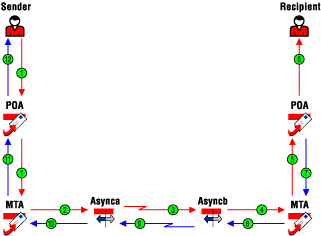Message Delivery Between GroupWise Domains
If two domains are to communicate through an Async Gateway, both domains must be running an Async Gateway. The gateway can be created and installed in the primary domain or in any secondary domain.
This diagram of the message delivery between domains shows the GroupWise components involved in the process.

User
A user object in eDirectoryTM that has been given a GroupWise account. Users can receive messages from and send messages to other users, act as resource owners, or act as GroupWise administrators.
Post Office Agent
The Post Office Agent (POA) is the GroupWise program that delivers messages to users' mailboxes in each post office. In addition, the POA detects and repairs damaged databases, replicates shared folders between post offices, performs the indexing tasks of document management, and responds to requests from Remote client users.
Message Transfer Agent
The Message Transfer Agent (MTA) is the GroupWise program that routes messages between post offices, domains, and gateways. In addition, an optional message logging module of the MTA can provide logging and statistics data about GroupWise message traffic.
Async Gateway
The Async Gateway is the GroupWise program that enables asynchronous communication (through modems and telephone lines) between domains on the same GroupWise system or between domains in separate GroupWise systems. It also allows remote GroupWise users to access their Master Mailboxes through modem communication.
Process 1: User Sends Message
The user sends a message from the GroupWise client, then the POA delivers the message to the MTA.
Process 3: Async Gateway Transfers Message
The Async Gateway in the sender's domain transfers the message through a configured modem and phone line connection to the receiving Async Gateway located in the recipient's domain.
Process 4: Async Gateway Queues Message
The Async Gateway in the recipient's domain queues the message to the MTA in the recipient's domain.
Process 6: POA Updates Message
The POA updates the message database and the recipient's user database.
Process 7: POA Generates Message Status
The POA generates a Delivered status message and queues it to the MTA.
Process 8: MTA Delivers Message Status
The MTA in the recipient's domain transfers the Delivered status to the Async Gateway in the recipient's domain.
Process 9: Async Gateway Transfers Message Status
The Async Gateway in the recipient's domain transfers the Delivered status message to the Async Gateway in the sender's domain.
Process 10: Async Gateway Transfers Message Status
The Async Gateway in the recipient's domain transfers the Delivered status message through the modem connection to the Async Gateway in the sender's domain.